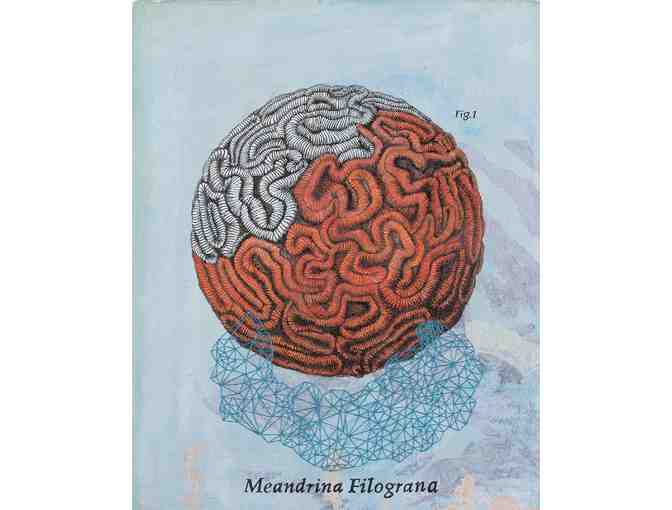Art
A. Eschenlauer - Meandrina filograna
- Item Number
- 1
- Estimated Value
- Priceless
- Opening Bid
- 200 USD
Item Description
ARTIST: Alain Eschenlauer
TITLE: Meandrina filograna
MEDIUM: Acrylic, ink and thread, 16” x 20”, unframed
This original artwork was created for Art on Science: 26 études an internattional portfolio featuring pictures by artists and words by scientists. This written commentary is by Marie Meister, a biolgist at Musée Zoologique de Strasbourg:
I am a biologist and have spent many years studying immune mechanisms. However, some 13 years ago I moved to the Zoological Museum of my city to take care of its collections, where I work now for the preservation, inventory and promotion of its impressive scientific heritage which has accumulated over some 250 years. This collection reflects both the unquenchable curiosity of Homo sapiens towards the natural world that surrounds us, and our inclination to destroy it since many of our specimens correspond to extinct species or to species that are threatened by our deeds.
I am always surprised to witness how much these inert artifacts, relics of lost lives, attract numerous artists, photographers, painters, sculptors who try to capture their substance through their work.
My daily environment in the Museum thus combines the two facets of our human civilisations, namely Science and Art, which to my eyes somehow compensate for part of our globally deserved stigma. Science because it drives humans to try to unravel the world in which they have evolved, the infinitely small, molecules, living cells, organisms, natural environments, planet history, but also space, planets, galaxies, the infinitely large, and all the laws that govern these various elements. Art, because it sublimates its beauty and helps us to forget briefly, or on the contrary to realise, that everything around us entails a death inherent in its very existence.
Alain chose to illustrate Cnidaria by picturing a stony coral and a gorgonian, both belonging to groups of magnificent marine organisms which are today threatened by unrestrained human activity. The Cnidaria phylum that evolved some 600 million years ago are animals exhibiting a characteristic radial symmetry that is easily observed in hydra and in jellyfish. Many cnidarian organisms have, however, developed a colonial lifestyle and for this they build calcite or protein structures that are often delicate, sometimes formidable. They are the exoskeletons that harbour the polyp colony and they make up the architecture of the so-called coral reefs which are hotspots of marine biodiversity. Reef coral cells contain single celled dinoflagellates with which they live in symbiosis. Through their photosynthetic activity, these algae provide corals with organic carbon products and energy. They are the cells that are expelled from coral polyps because of global warming and pollution of tropical seas, which trigger massive coral death and thus lead to ‘coral bleaching’.
Alain wants to illustrate corals that are undermined, a stony coral gnawed at by the white leprosy that is going to doom it, a gorgonian with altered lacework. The artist intends here to challenge the visitor and to confront him with the consequences of our lifestyles, by using powerful displays of eroded beauty, which do not need explanations.
Item Special Note
Free domestic shipping.
All artworks are 16” x 20”, unframed and will be shipped with a printed copy of the scientist’s text.
For further information about the portfolio, please visit our website: http://AS26project.com
Mosesian Center for the Arts stores data...
Your support matters, so Mosesian Center for the Arts would like to use your information to keep in touch about things that may matter to you. If you choose to hear from Mosesian Center for the Arts, we may contact you in the future about our ongoing efforts.
Your privacy is important to us, so Mosesian Center for the Arts will keep your personal data secure and Mosesian Center for the Arts will not use it for marketing communications which you have not agreed to receive. At any time, you may withdraw consent by emailing Privacy@frontstream.com or by contacting our Privacy Officer. Please see our Privacy Policy found here PrivacyPolicy.

